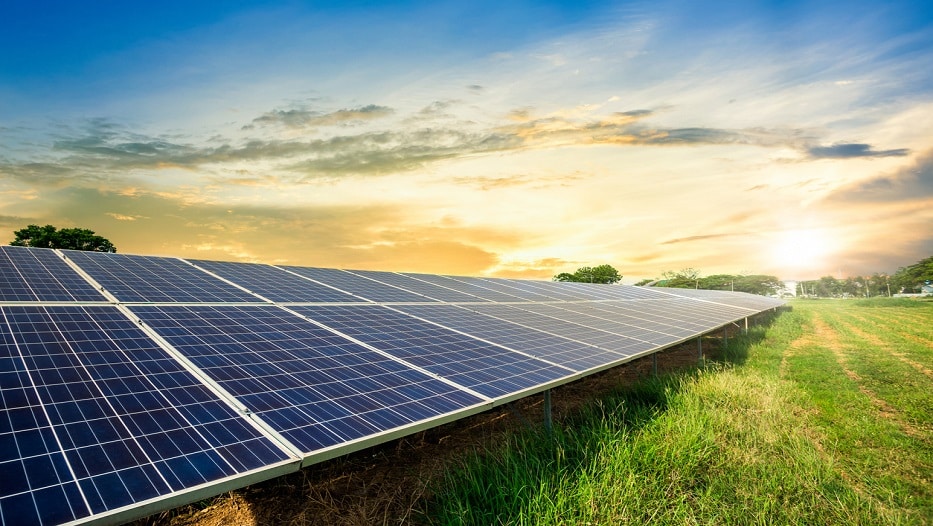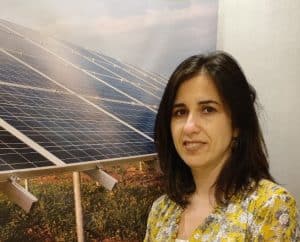Julia Maria Gomez de Avila Segade | 29/09/2022
Following the pandemic and the energy crisis, renewable energies and, above all photovoltaic solar energy, have experienced exponential growth, helped in turn by the path marked out by Europe on the green economy and sustainability. AGROVOLTAICA was created with the aim of trying to demonstrate the feasibility of preserving, restoring and improving the agricultural use of soil in “solar orchards” so that photovoltaic installations do not displace other uses of the land.
Following the pandemic and energy crisis, renewables have experienced exponential growth, driven by a global commitment to the green economy and sustainability. In this context, various lines of research have come into being to make technological developments profitable and optimize resources. One of the most promising initiatives is the synergy of the energy industry with other sectors that has resulted in agrovoltaic technology, which allows the simultaneous use of land for both the generation of solar photovoltaic power, as well as cultivation.
In Spain, significant progress has been made in this area by CYLSOLAR, a non-profit entity that was created in 2010 from a significant nucleus of companies in Castilla y León. Maria Jesús Jiménez, coordinator of the AGROVOLTAICA project, tells us about the situation and future of this initiative that aims to preserve, restore and improve the agricultural use of soil in “solar orchards”, so that photovoltaic facilities do not displace agricultural use. “This double coexistence allows for a reduction in the environmental impact. Depending on the type and use of land occupied, it is possible to match the generation of this renewable energy with agricultural or livestock use, which, in addition to producing additional economic and social benefits, prevents the degradation of the land,” she explains.
Long-haul technology
In the Iberian Peninsula, interest in agrovoltaic technologies has grown in recent years, as the benefits obtained from its development are becoming increasingly apparent:
-
-
- Sustainability and mitigation of climate change. Through land sharing for energy and agricultural use, an improvement in soil quality takes place, favoring biodiversity, as soil degradation is reduced.
- Reduction in the use of water and the protection of crops located in these “orchards” from the elements, could lead to new agricultural business models.
- Temperature reduction in the power installation itself, which enhances production and improves operating conditions.
- Economic development and social well-being. These centers are usually located in rural areas, which are benefited by not reducing their agricultural capacity for the cultivation of new species, thus generating additional agricultural income.
-
With regard to the technical characteristics of this type of power generation, the expert explains that “the most widely-used concept currently is the integration of agricultural use in photovoltaic projects that have been already built (as in pilot schemes being developed at AGROVOLTAICA). In this case, we start from installations already designed and implemented without considering agricultural use, for which it is about integrating an agrovoltaic model. There are no facilities or supporting infrastructure adapted to the model here, so it is the agrarian use that is adapted to the power installation.”
She also points out that, to a lesser extent, there are companies that integrate agricultural use in the first phases of planning, so resulting in a design adapted to this double-use activity. “This dual approach has additional complexities compared to the standard solar-based system and requires a significant degree of foresight to maximize quality and ensure efficient operation,” she says. However, while allowing greater maneuverability in terms of the agricultural activity to be carried out, this approach is usually in detriment to the power generated.
Implementation challenges
As María Jesús Jiménez explains, the main choice for this industry is its own land, particularly when it comes to re-adapting a space that was already being used. “These facilities are designed to house an exclusively energy-based business so the conditions are not ideal for the development of any type of agricultural project, not only because of the distance between the panels and the land to be cultivated, but also because of the agronomic conditions of the soil and the shade created by the panels,” she says.
Designing these agrovoltaic models is a challenge, as agricultural use is wholly conditional on factors of location and the construction of the power installation itself:
-
-
- Edaphoclimatic characteristics of the area. Agricultural soil suitability, depth, acidity, fertility, texture, topography, historical soil use, etc.
- Local socioeconomic aspects. Labor, market development, co-operatives, factories or profitability.
- Existing infrastructure.
-
“It makes the renewable sector more sustainable by taking care of the land it sits on and, from the agrarian aspect, the use of ecologically responsible energy is encouraged”
Another important aspect to keep in mind, as explained to us by the CYLSOLAR Cluster Manager, is that agrovoltaic use “is not compatible with all crops and is particularly more beneficial with those that require more shade”. In order to determine which are most effective, field testing is required. “Our project has pilot schemes underway in three autonomous communities. Five different types of permanent prolyphite meadows – which are the ones with the greatest potential to increase diversity – and aromatic plants in the free areas are being tested in Castilla and León. In Extremadura, the proposal is to improve vegetation coverage, accompanied by regenerative management with sheep. Finally, in the Valencian Community, aromatics have been planted in areas of free soil, with the aim of determining the economic performance of this crop under dry and irrigated conditions, so that they are profitable in areas with photovoltaic installations,” she says.
Insights & Roadmap
The development of agrovoltaic technology in Spain is still incipient and requires two necessary catalysts: investment to test initiatives with different types of crop and regulation that facilitates their development. “It requires specific regulations so that this new model can be implemented more safely and so that the regulations define the characteristics desired,” Jiménez says.
In contrast, this technology will support both the agricultural and energy sectors in meeting their sustainability goals. “It makes the renewable sector more sustainable by taking care of the land it sits on and, from the agrarian aspect, the use of ecologically responsible energy is encouraged,” she warns.
In addition to agriculture, other sectors could also support the use of solar panels. “It’s a very robust and versatile technology, and above all, the installations are very profitable, and they’re increasingly cost-effective because of the high energy prices we’re seeing at the moment,” she concludes.
Article Collaborator:
Maria Jesús Jiménez is a Doctor of Economics from Valladolid University. She has a long history in the renewable sector, being the CYLSOLAR Cluster Manager of the Renewable Energy and Energy Solutions Cluster in Castile and León since its inception in 2010, an entity where they work with companies in the sector in the development of innovative projects that improve their competitiveness and give rise to new business models.
The GO AGROVOLTAICA operating group consists of six companies belonging to the agrarian and energy sectors, located in Castilla y León, Extremadura and the Valencian Community, quintessential agricultural territories that are home to a multitude of solar photovoltaic projects.
The project has, from the energy aspect, the Renewable Energy and Energy Solutions cluster in Castile and León (CYLSOLAR) and the Extremadura Energy Agency (AGENEX).
On the other hand from the agrarian aspect, there are two technological centers: the Extremadura Center for Scientific and Technological Research (CICYTEX) and the Agrarian Technological Institute of Castilla y León (ITACYL), as well as a farming association, La Unió and a business association, CEOE Ávila, which brings together other significant agricultural entities.
In addition, it has as collaborators with the Provincial Agency of Energy of Avila (APEA) and through the subcontracting of the Foundation for Research and Development in Transport and Energy (CIDAUT).
The project is being co-funded with 80% coming from the European Agricultural Rural Development Fund (FEADER) and 20% from the Ministry of Agriculture, Fisheries and Food, under aid granted for the development of innovative projects of general interest (by supra-autonomous operating groups, AEI-Agri) within the framework of the National Rural Development Program (PNDR). Total aid granted amounts to €409,420.30.
Keep reading… Floating panels: a new breakthrough in solar energy






